How often and correctly water the carrots?
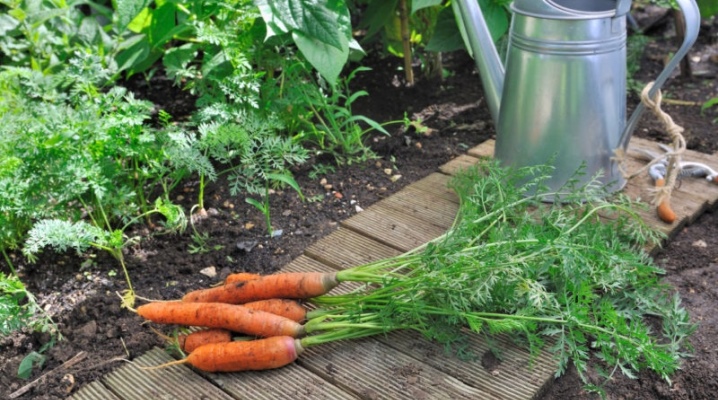
Many gardeners are engaged in the cultivation of carrots. This process is successful only with regular irrigation of the crop. Despite the fact that the plant is unpretentious and, in principle, even copes with drought, it is possible to get sweet and strong vegetables only by regularly providing them with the necessary amount of moisture.
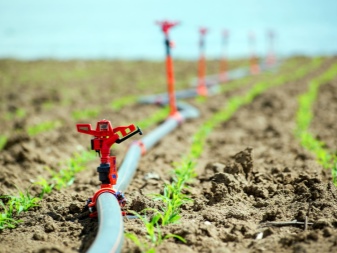
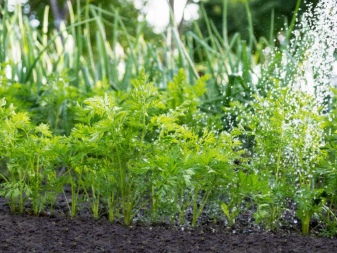
Water requirements
Some novice gardeners mistakenly believe that in the heat it is worth watering the plantings with ice water taken from a well. It is not worth doing this, since sudden changes in temperature will significantly harm the culture's immunity, making it more susceptible to diseases. Moreover, the roots of the plants will receive thermal stress, which is why they will partially die off or undergo root rot. Watering carrots should be carried out with a liquid, the temperature of which corresponds to the air temperature. In hot periods, you can irrigate the plantings with slightly cool water, but on cloudy days you need to water it with warm water.
The liquid should be heated naturally. To do this, you need to fill some large container, barrel or old bathtub, and then put it in the sun. When the water warms up, all that remains is to pour it into the watering can or pump it into the tank using a pump. The rule regarding water temperature is relevant both for open ground and for a greenhouse. It is better to take natural rainwater, collected during heavy rains, or pond water, and in the case of tap water, give it the opportunity to settle for 24 to 48 hours. Ideally, the latter is still best avoided, as it often contains chlorine and other impurities. The hard liquid is softened by the addition of peat or wood ash.
It is better to focus on the temperature range from + 22 ° C to + 24 ° C, although the culture will cope with liquid temperatures from + 18 ° C to + 20 ° C coming from the hose.
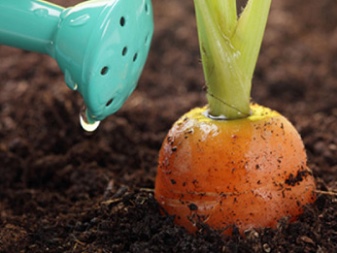
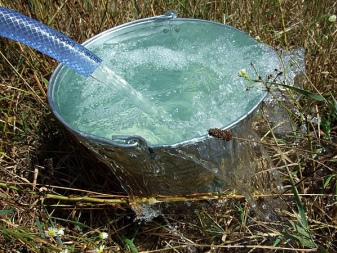
Is it better to water in the morning or evening?
Like many other crops, plantings should be irrigated either early in the morning (although sometimes it is allowed until lunchtime), or late in the evening (at least after 17-19 hours). Watering in the middle of the day will cause the moisture to evaporate too quickly, and the plant will simply not have enough for the night hours. On the other hand, the combination of sunlight and water can contribute to burns. If you still have to water the carrots in daylight, then you will have to do this as carefully as possible, avoiding splashes on the leaves and shoots. On cloudy days, daytime irrigation can be carried out without additional precautions.

Watering rates and frequency
The frequency of irrigation of carrots is determined depending on the period of development in which the culture resides. Of course, in hotter and drier weather, the amount of irrigation becomes more frequent, and in rainy and cloudy weather, it decreases. Novice gardeners can follow an approximate scheme, implying that in May the beds are irrigated 7 times using 5-7 liters per square meter, and in June the frequency is reduced to 5 times, but with pouring 10-11 liters per square meter. In July, 4 irrigations with a volume of 12-14 liters per square will be enough for plantings, and in August their number should be cut in half - up to 2 times and up to 5-7 liters for the same area.


After landing
In order for carrot seeds to germinate successfully, they require an abundant amount of moisture, so the soil will have to be moistened both before and after sowing. In the spring, a couple of days before the planned planting, future beds are thoroughly irrigated. For this purpose, you can use both plain water and a solution of potassium permanganate, which additionally provides soil disinfection. Directly on the day of planting, grooves are formed on a wet surface, where the seeds should then be planted. Having covered them with earth, it will be necessary to irrigate the beds again.
Planting should be watered quite often until shoots appear. Additionally, it makes sense to also cover the beds with cling film, which will create a greenhouse effect and, as a result, promote the fastest germination of the seed. From time to time, the coating will have to be removed in order to water the plantings again, as well as arrange ventilation. Keep the film on the beds until the sprouts appear on the surface. Young plants will have to be moistened 2-3 times a week, and even more often if the weather is hot.
Each square meter of plantings should receive about 4-5 liters of water, but plantings should not be flooded, otherwise the culture will become infected with a black leg.
After watering, surface loosening of the soil should be carried out, which prevents the formation of a crust and ensures a trouble-free supply of oxygen to the root system.
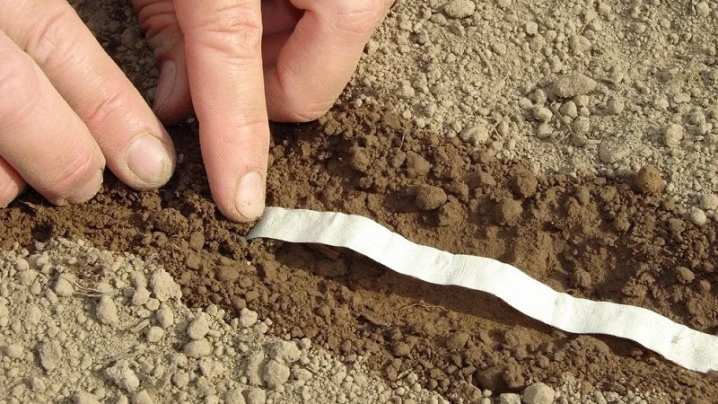
During the filling of root crops
In the summer, already somewhere in June, the pouring of root crops begins. Usually, this stage starts from the moment of the formation of full-fledged 4-5 sheets. At this time, it is correct to cut back on the number of irrigations, but to increase their volumes. On average, about once every 1-1.5 weeks, about 2 buckets, from 15 to 20 liters, will have to be poured for each square meter. It is important that the soil is soaked to a depth of 10 to 15 centimeters, but that moisture does not stagnate.
Watering must be accompanied by loosening the soil in the aisles. Lack of liquid will cause the fruit to shrink in size and taste noticeably worse. Nevertheless, excess moisture is also harmful to the crop - in this case, ugly lateral processes grow on the carrots itself, and the central root dies off. In the future, the carrots should be irrigated regularly, but in moderation. When the roots are practically formed, watering is reduced to a minimum.
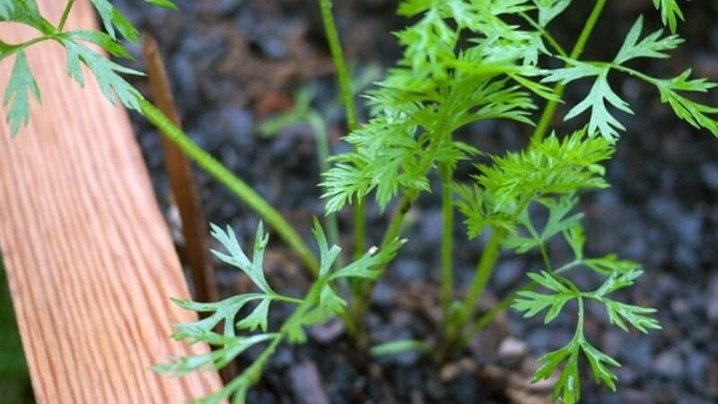
Before harvest
Approximately 2-3 weeks before the harvest, the crop is completely stopped to water. Of course, if the weather remains hot and dry, then the rule changes slightly - the last time it is allowed to irrigate plantings is a week and a half before harvesting. If the carrots still receive excess moisture during this period, then its fruits may crack or become waterlogged and subsequently begin to rot in storage. To avoid such problems, wet carrots removed from the ground are dried in the beds or in a dry room.
Some growers prefer to lightly irrigate the soil just before harvesting the roots to make it easier to dig them up.
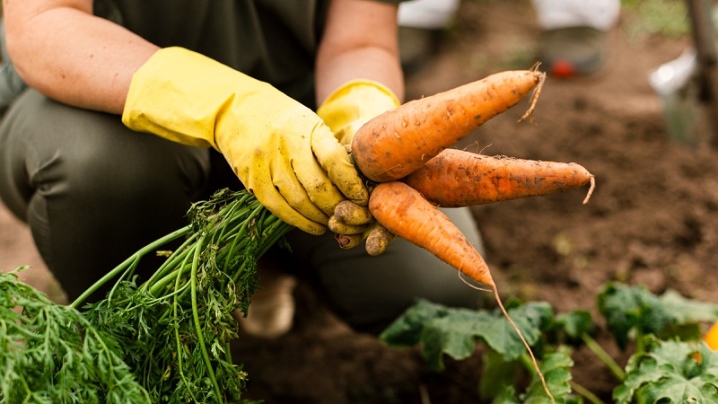
Irrigation methods
It is important for carrots that moisture is gradually absorbed into the soil. To achieve this, the same section of the garden should be irrigated in small volumes for 2-3 times. It is best to irrigate the crop directly under the root or along the grooves. Sprinkling will also work, but in this case it makes sense to prepare for the appearance of a carrot fly. Most gardeners prefer to water the roots with a watering can until the sprouts appear, and then, when the sprouts are a little stronger, switch to watering with a hose with a slight pressure of water. By the way, if the gardener has to be absent for a long time, it is better for him to use irrigation along the grooves, which have a slight slope, which are covered by the tops of weeds.
For work, a watering can with a long pipe and a small nozzle with fine holes is best suited. It's good if it turns out to be removable - this will make it possible to clean and change the part if necessary. A watering can will allow you to evenly distribute drops over the entire surface of the beds, as well as prevent seeds from washing out and churning into a heap. When using a hose, use the correct design with a spray at the end. To increase yields, some vegetable growers turn to drip irrigation, which, however, requires the installation of a special system. Judging by the reviews, this method increases the number of fruits by 2-3 times, significantly reducing the waste of time and moisture itself. Drip irrigation allows water to be directed directly to the root system of the plant, which improves the development of the fruit mass.
A combination of watering and mulching is considered a reasonable solution. The presence of a layer of mulch will allow you to maintain humidity for as long as possible, normalize the temperature regime, fight weeds and increase the fertility of the soil. But the main thing is that this will allow you to abandon the loosening procedure and save a lot of time, since the soil crust simply cannot form. Watering mulched soil is rarely necessary, but abundant. Rotten sawdust, needles, bark, wood chips, straw and peat are suitable as mulch for carrots. The layer thickness should be up to 5 centimeters. As mentioned above, in the absence of mulch, irrigation should always end with loosening in the aisles and weeding out weeds. Both of these procedures are carried out only after the water is finally absorbed into the ground - that is, after two hours. The tool usually goes 3-5 centimeters deep.

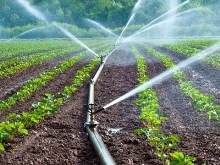
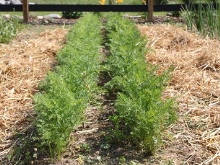
Useful Tips
To add sweetness to root vegetables, from time to time they should be watered with a weak solution of table salt. The intake of this substance will increase the carotene content in carrots, which, in turn, will improve its characteristics. Salt is especially useful on infertile and heavy soil mixtures. The solution should be applied in late July and early August, that is, at the stage of root crop formation. To improve the condition of the soil, it will be enough to add a couple of tablespoons of salt to each bucket of water.
To prevent putrefactive processes and activate the development of vegetables, it will be necessary to dilute a tablespoon of table salt in 10 liters of heated water. After thoroughly mixing the mixture, it must be distributed along the grooves. To speed up the effect of salt, the beds must be watered with plain water before watering with salty liquid. The procedure is allowed three times per season. In general, an excellent solution would be to combine irrigation with fertilization. It is important that this applies not only to dry mixtures, but also to solutions. If liquid fertilizer is used for feeding, then the beds are irrigated beforehand, and if dry, then irrigation is carried out later.
Besides, useful substances can be added to the water intended for irrigation. So, once a week, in every 10 liters of heated liquid, it is worth adding a liter of tincture of crushed wood ash. With the active growth of the root crop and during its ripening, it is customary to add a teaspoon of boric acid to each bucket of water. Every month planting can be watered with broths of nettle or supplemented with mullein or compost. By the way, in hot weather, some gardeners prefer to refresh the crop tops. This can be done only in the afternoon after the heat has subsided by using a unit with a "shower" nozzle.


It will be useful for novice gardeners to familiarize themselves with common mistakes when growing carrots and then make every effort to avoid them. First of all it is important so that the roots do not develop in dry soil, otherwise this will lead to the fact that they will coarse and find a too light middle. In addition, the vegetables will become bitter, which will certainly spoil the harvest. If the land turns out to be waterlogged, then the fruits, in contrast to the aboveground part, will slow down their development.The shape of the root crop will deteriorate, and it itself can begin to rot, become moldy and become infected with all kinds of infections. To prevent unpleasant consequences, the plants should be irrigated evenly, after the same period of time, and the amount of water should vary depending on the growing season and external conditions.
Some gardeners mistakenly place beds on a hill, which is categorically unsuitable for carrots. The vegetable ceases to receive a sufficient amount of oxygen, and moisture quickly goes into the lower layers of the soil, not providing the crop with a sufficient amount of it. However, such an arrangement would be appropriate if vegetables are planted in an area with a close occurrence of groundwater, as well as in wetlands.
Growing carrots in a greenhouse is basically the same as growing a vegetable in open beds. Watering should be timely and moderate. At the beginning of the growing season, it is reasonable to be guided by the condition of the soil - as soon as it begins to dry, the crops are irrigated. On hot sunny days, it is worth watering young bushes a couple of times a week, consuming 3-4 liters of water per square meter. From the beginning of the formation of root crops, watering is reduced to weekly, but 10-15 liters are consumed for each square meter. The irrigation procedure must be combined with loosening row spacings and removing weeds. Irrigation of the beds is stopped two weeks before the planned harvest.
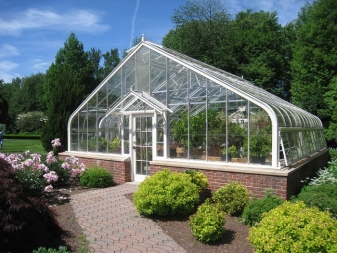
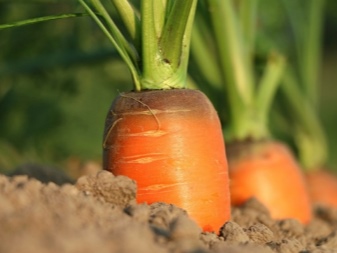
For information on how to water carrots from germination to harvest, see the next video.













The comment was sent successfully.